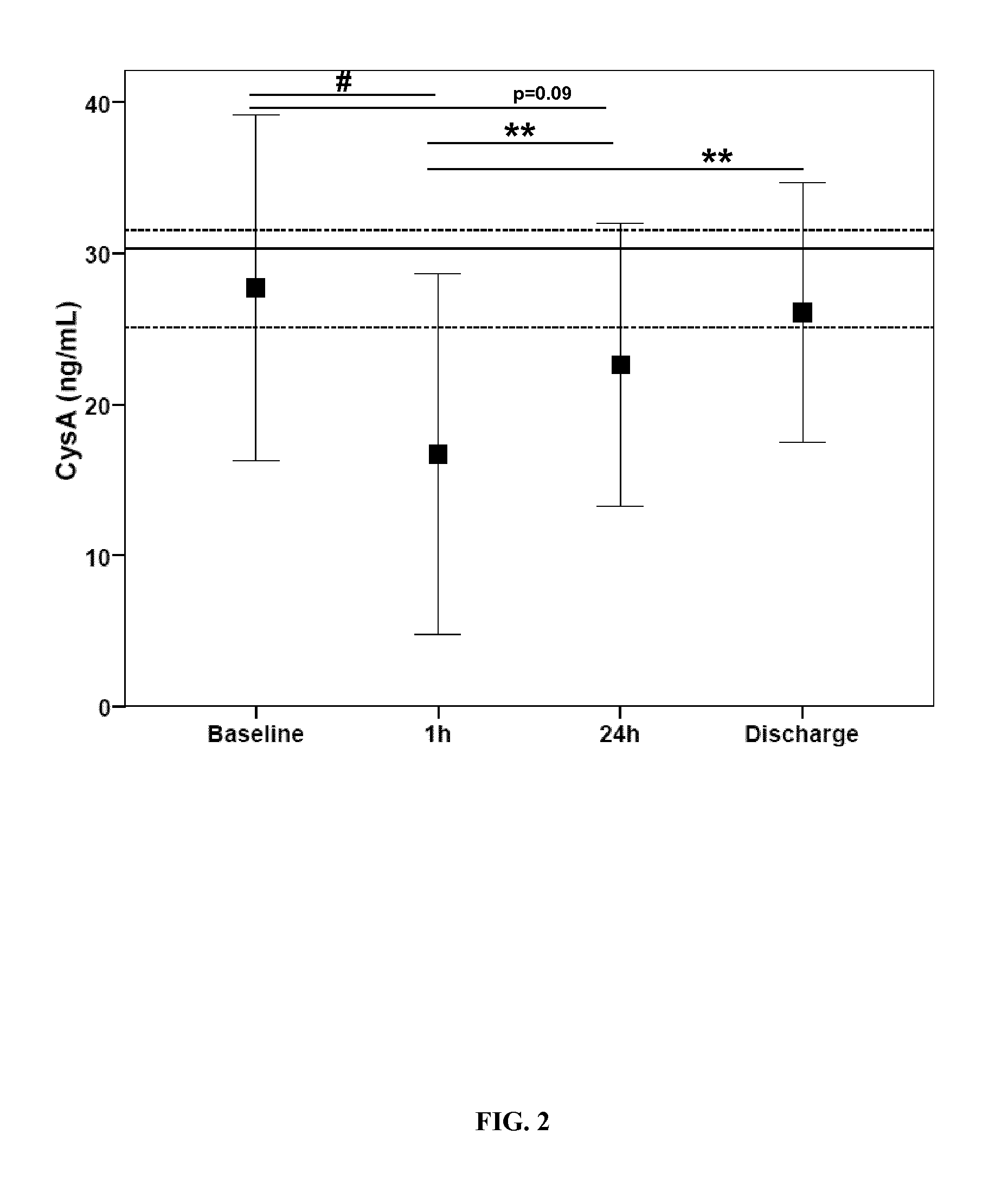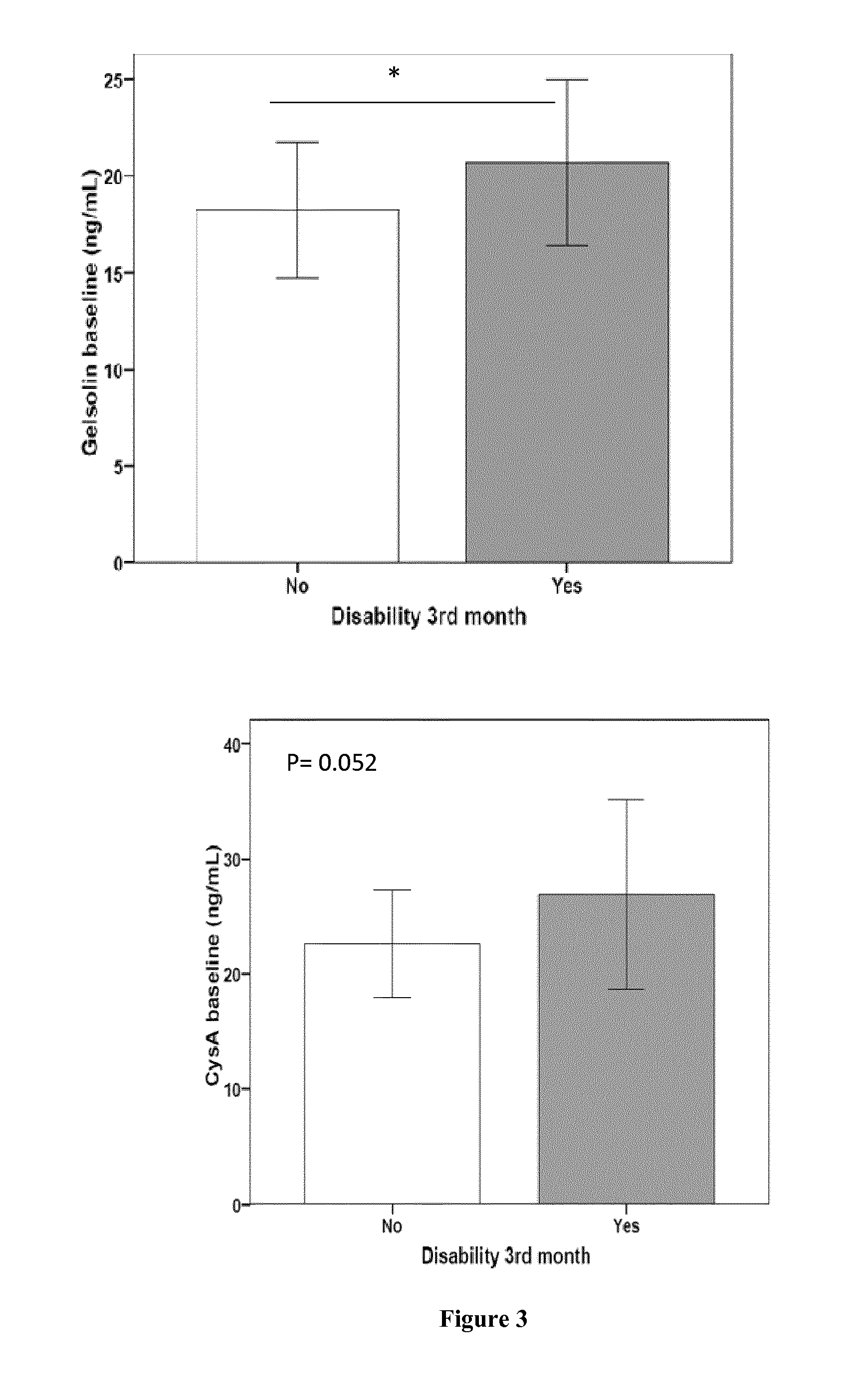Biomarkers for the prognosis of ischemic stroke
a technology of ischemic stroke and biomarkers, applied in the field of diagnostics, can solve the problems of sbis high prevalence, adverse health outcomes, and decreased blood supply to a part of the brain, and achieve the effects of improving the prognosis, improving the prognosis, and improving the prognosis
- Summary
- Abstract
- Description
- Claims
- Application Information
AI Technical Summary
Benefits of technology
Problems solved by technology
Method used
Image
Examples
example 1
Proteins Showing Differential Expression Profile
[0181]Brain homogenates obtained from the contralateral hemisphere (CL), peri-infarct (PI) and infarct core (IC) from 3 stroke patients and 3 controls (CON) were used to create a 2-dimensional protein map. On average, 1,442±231 protein spots were found in the gels and 132 spots have at least 1.5-fold changes in their relative expression between the different brain tissue areas. 42 spots and 39 unique proteins were successfully identified by MALDI-TOF / TOF MS and MASCOT algorithm (Cuadrado E. et al, J. Neuropathol. Exp. Neurol., 2010, 69(11), 1105-15).
[0182]20 missing protein spots were processed by ESI LTQ-OT MS, with higher accuracy and resolution, and 12 new unique proteins were identified (Table 1). From these, 5 proteins were over-expressed and 7 decreased in IC.
TABLE 1Proteins identified from 2D-DIGE (pH 3-10) of human brain homogenates by ESI LTQ-OT MS.AccessionMascotSpot No.Protein nameNo.MWpIScorePeptidesBlood coagulation1074Fib...
example 2
Verification of Potential Candidate Biomarkers with ELISAs
[0184]To identify potential biomarkers from the 51 proteins identified by MS studies, 8 candidates were selected from different functional categories based on the availability of commercial immunoassays. From the 39 proteins identified by MALDI-TOF / TOF MS four proteins were chosen as candidates, two of them having less expression in IC (GPBB and Septin-5) and DPYSL2 and Rho GDI-1 being higher in IC (Cuadrado E, 2010). On the other hand, CACYBP and gelsolin (lower expression in IC) and CNTN-1 and CysA (higher expressed in IC) (Table 1) were selected from the 12 proteins identified by ESI LTQ-OT MS.
[0185]When assayed in blood samples either GPBB, Septin-5 and CACYBP were non-detectable neither in plasma nor in serum. Finally, ELISAs were performed for gelsolin and CysA (plasma samples) and Rho GDI-1, DPYSL2 and CNTN-1 (serum samples) in 60 ischemic stroke patients followed-up till 3rd month after stroke. The median age was 77 y...
example 3
Blood Temporal Profile
[0186]CysA showed differences among temporal profile, decreasing its level 1 h after thrombolytic treatment administration (p<0.001) and recovering control reference level at discharge (FIG. 2).
PUM
| Property | Measurement | Unit |
|---|---|---|
| temperature | aaaaa | aaaaa |
| flow rate | aaaaa | aaaaa |
| isolation width | aaaaa | aaaaa |
Abstract
Description
Claims
Application Information
 Login to View More
Login to View More - R&D
- Intellectual Property
- Life Sciences
- Materials
- Tech Scout
- Unparalleled Data Quality
- Higher Quality Content
- 60% Fewer Hallucinations
Browse by: Latest US Patents, China's latest patents, Technical Efficacy Thesaurus, Application Domain, Technology Topic, Popular Technical Reports.
© 2025 PatSnap. All rights reserved.Legal|Privacy policy|Modern Slavery Act Transparency Statement|Sitemap|About US| Contact US: help@patsnap.com



